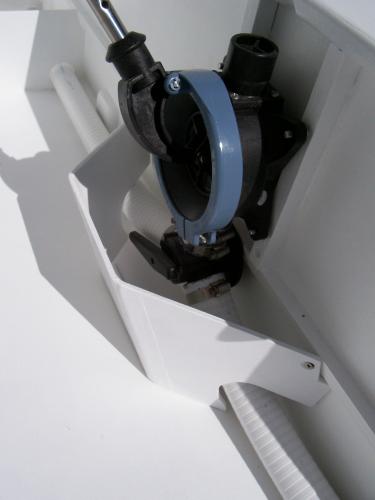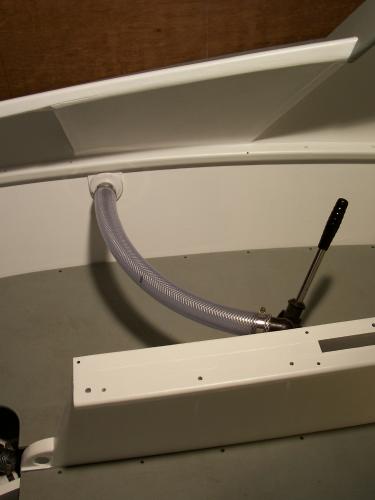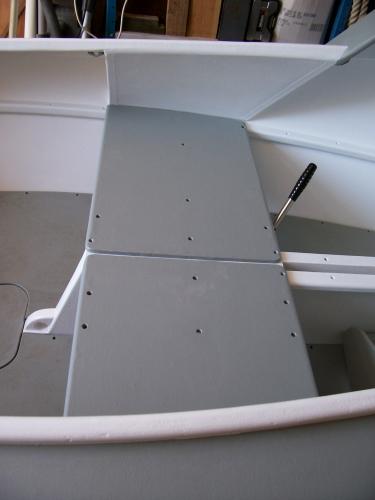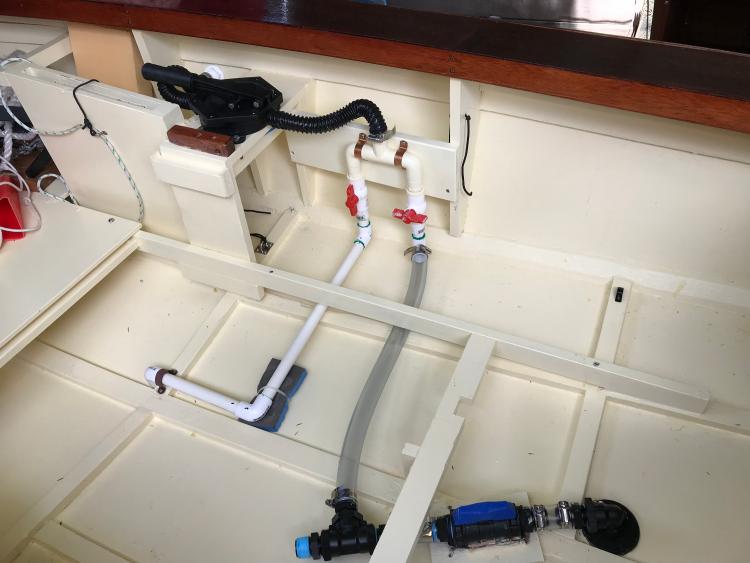Bilge - Bail or Pump - Manual or Electric
|
|
A capsize can focus the mind.
Do you have a bilge pump in your dinghy? If you do:- Where is it mounted? Where is the suction point? Is it electric or manual? Do you recommend anything in particular? (Or to avoid?) What size is your dinghy? Any other thoughts? Thanks Paul W (PS - Posted similar on "MyMorbic") |

|
Paul H (admin) |
Re: Bilge - Bail or Pump - Manual or Electric
|
|
Yes
Rear of cockpit well Electric Electric pump bails water automatically, giving precious time to regain control after a knockdown 14ft pocket cruiser. Auto float switch is excellent, but you need a 3 way switch Off-Auto-On. On is used to clear rainwater in the morning. Ideally create a sump for the pump. Paul |
|
|
Thanks (Paul H) for your comments.
It makes sense to be able focus on safely sailing while a pump clears out the consequences of a mishap. Not much chance of creating a sump in our floorless Morbic 12, but a solution can be found. Paul W |

|
Paul H (admin) |
Re: Bilge - Bail or Pump - Manual or Electric
|
|
In reply to this post by Paul H (admin)
A few more details:
My pump is on the starboard side, and the pipe exits through a fitting in the transom. I move to starboard and she heels enough for the water to collect near the pump, which removes the most water possible. The last 5-10mm cannot be pumped away. One day I will fit a sump, 20mm deep is enough, so that all the water drains into the sump and is pumped away, leaving the cockpit free of water. That involves cutting into the cockpit floor, which has to be sealed perfectly as it forms a buoyancy tank between two bulkheads. Only some pumps have a float switch, they are worth the investment to get automatic operation during maximum stress! Paul |
|
|
in all my years of dinghy sailing, I've generally found a bucket is the best thing for mass water ejection, followed by a cut off 6 pint plastic milk bottle for scooping the rest out..
That applies to the 20ft open keel boat I race too. The Bucket has other uses too.... Certainly not electric, in a small dinghy the battery needed to empty large amounts of water rapidly would be huge for the dinghy size. A manual pump could be used but they are only effective for the last bit if you have a sump.. if you have slight rain ingress problems, then a small electric pump with float switch and a solar panel to charge the battery, is a good idea.. |

|
Chris Waite |
Re: Bilge - Bail or Pump - Manual or Electric
|
|
In reply to this post by Paul W
Starting from the point of view of "a frightened man and a bucket" being the best bailing equipment afloat
(You do carry a bucket, tied on; don't you?) Electr(on)ics and sea water are a very poor combination and always will be. This doesn't stop a lot of people having any number of pieces of electrical kit on their dinghies, including bilge pumps. This seems like tempting fate to me and I don't hold with it. A manual pump is vastly more simple and reliable and good exercise to boot. It's a dinghy for heaven's sake; your not trying to land it on Mars, or anything. As a cruising dinghy, I set up my chosen conveyance with a small (removable handle - also attached with a length of light rigging wire, to discourage the light of finger) Whale pump....  Which they seem to have stopped producing, or possibly relabelled it. My boat has a water-ballast system, so I included it in the pumping arrangments. It fills naturally on opening the seacock and similarly drains on pulling up onto the shore; but I can also pump it out at sea. It is advantageous to be able to pump while sailing, so the pump is mounted on the (port side of) the centreboard case with the handle working athwartships. This means that you can sit on the thwart itself and pump on either tack. The exit pipe runs under the thwart and drains through a skin fitting on the side of the hull at that level, perhaps nine inches above the waterline -  The gubbins low right in the picture is all to do with the water-ballast, (seacock handle in red). The strum-box equivalent is the white pipe running forward toward the mast step; the end is stoppered off and there is a series of holes in the underneath to act as a filter and catch the dregs -     To explain; there are three two-way valves in the system. One each for the two water bags that hold the ballast, connecting each either to the seacock, or the bilge pump. Then there is a third under the pump itself, which connects either to the ballast system, or the bilges. In practice these valves are stiff to handle and I really have not used them very much. They almost exclusively remain with the ballast bags connected to the seacock and the pump connected to the bilge strum hose. If you think I am being unfair to electronics, consider the following - Some thirty-six hours ago I received an email to say that a four-gang switch was 'playing up' in another property for which I am responsible. I have a pet electrician there locally, so I tried to phone him, but could only leave him a message. I passed the message back that I'd asked him to contact the occupant. I left another message about twenty-four hours ago; nothing. Tried again with another message this morning and went out for the day, emailing the occupant with the lack of progress the while. Tried again this afternoon; still nothing, then when I was cooking the evening meal amidst the roar of the extractor fan and the fridge 'meeping' irregularly over the top of the din, as its door switch, which is also faulty, thinks its open when it isn't.... then the electrician decides to phone back, but the cordless handset in the kitchen fails to ring and it is only the sets at the other end of the house that eventually impinge on our consciousness over the row from the fan and fridge. But too late, the electrician (for it was he) rings off and phoning him back reverts to his answering machine. Eventually he does try again and it seems he has been sending text message replies to me at somebody else's number. What are you going to do when your electrics fail you? All that arrant tosh for a faulty switch Instal a hand pump Chris |

|
Jason Mayer |
Re: Bilge - Bail or Pump - Manual or Electric
|
|
Yep I'm with Chris,
This was my setup and will be again soon in my new boat.  Hand pump with suction inlet in the bottom and a fitting in the side of the hull. Ignore the ballast suction inlet. That allowed me to empty my ballast at sea. Jason |
|
|
Hi Jason, that looks a very neatly arranged system - presumably the idea is to be able to pump from two different places, or three if you connect something to the tee that looks to be blanked off. Wondering what is the blue and black thing nar the suction on the right of the picture?
The only pump on our sailing dinghy is a fresh water pump that is also a tap, that connects to a fresh water tank and it is a surprisingly nice luxury for dinghy cruises of any duration. We dont have a bilge pump because the floor inside the boat is a little above the waterline (at the lowest point, only 20mm above the waterline by design, maybe 10mm now - boats seem to gain weight over the years). There is a sort of covered trough transvers across the lowest part of the floor so water drains into that and is then extracted by a self bailer thing at the bottom of the trough. If the boat is heeled over a lot then not all the water drains out - some remains on the lee side which doesnt have to matter - we would be sitting on the high side if the boat is heeling so our feet will still be dry. The centreboard case is wide, at least 60mm and is mostly below the floor level. There is a removable cover on the top of the centreboard case and if lots and lots of water comes into the boat we can whip that cover off which lets most of the water drain out though a hole at least 60mm x 450mm straight through to the sea. Only needed to do that a few times during the history of the boat, and all but one of these occasions were when I was young and irresponsible and used to go sailing around places like Alderney race with no real knowlege of what the conditions might be like. In recent decades I have had only one such experience, Alastair will know all about this since we were sailing in company with him in his Paradox boat at the time. Breaking waves on the bar of the Devon Avon, not all that windy but it was probably just the worst point of the tide cycle, a spring ebb against an onshore breeze, we had not anticipated what it was going to be like. I dont think they were all that huge waves, but they were the kind with the tops curling over and coming down on our boats. We rolled about helplessly, pretty well unable to steer and we took lots of water which did drain out of of our boat quickly enough. Then, quite suddenly we were clear of the bar and all was back to normal. Alastair said afterwards that the Paradox was rolling its mast under water with water coming in through the hatch which had to be open because he was trying to steer by holding the rudder stock, the tiller having snapped when a wave forced the rudder over. Alastair managed to sail/drift back into the shelter of the river, we carried on to Hope Cove then Salcombe with no further difficulty. I guess that the inside of Alastair's boat might have been a bit like the inside of a washing machine that turns one way then the other, his electronics were soaked so we were unable to contact him during the day so we went looking for him by car from Salcombe -eventually found him safe and sound in the 'Fisherman's Rest' at the head of the river Avon. Hope no more experiences like that ever, at least not till the next time. |
|
|
So, currently we have:-
For Electric = Paul H, Paul W. For manual = The Q, Chris W, Jason, (John P?). Any more votes? Paul H's sage comment "Electric pump bails water automatically, giving precious time to regain control after a knockdown" is quite influential. When sailing single-handed I don't have quite enough hands to control the boat and bail manually, especially in capsize-inducing conditions. Sailing two-up is a different kettle ..... Manual is fine. Research and calculations (with allowance for inefficiency) suggest that a suitable battery & pump+switch combination could give sufficient clearance for 4 or 5 swampings of the Morbic 12. I'm hoping to test the concept with a borrowed battery and pump. Incompatibility of electrics & saltwater is well known, but there are affordable precautions (and we have an engineer on board.) Chris W - Was the failed "four-gang switch" 250 V or 12V? Pump installation in the Morbic would probably be alongside the CB case beneath the centre thwart. Chris W's "Strum box" (pipe-end stoppered off. A series of holes underneath to act as a filter.) looks ideal to provide more than adequate pickup in the Morbic context, and in exactly the right place, alongside the CB case. On the other hand, an in-line pump will not have an integral float-switch. |

|
Paul H (admin) |
Re: Bilge - Bail or Pump - Manual or Electric
|
|
This post was updated on .
Paul,
Wherever you fit an electric pump, you must be able to quickly disassemble it and unblock the seaweed and stones that can collect. I used thick heat shrink tubing to protect the wires which along with the curve of the ribbed pipe sort of pushes the pump into the cockpit corner. It can be opened in seconds, all pumps have pull off strainers, although it has never blocked. Don't forget rubber diaphragms can degrade and split. To hedge your bets, you could fit both mechanical and electric pumps. The portable vertical pumps are great for bailing out lockers - on the Thames after a storm I opened a locker to see food floating in 200mm of water. These unexpected things just happen. Edit: To meet the reliability of aircraft electrics (one failure in 10,000 hours) the systems must cope with extremes of temperature, humidity, vibration, mechanical damage and corrosion. Rocket science is not needed, common sense goes a long way. -Paul |

|
Chris Waite |
Re: Bilge - Bail or Pump - Manual or Electric
|
|
In reply to this post by Paul W
Well, Paul W
Though I do have a mainsheet jammer, I reckon to be able to steer with one hand and pump with the other, as being enough to maintain some sort of mastery of the situation, while putting the oggin back where it ought to be. Perhaps comparable to playing the guitar, but not as confusing as trying to pat your head and rub your tummy at the same time. With a stern mainsheet you might hold both that and the tiller in a one-handed, vice-like grip?? As for the four gang switch, it is mounted next to the bathroom door at some fifteen feet above sea level, (that's what Google Earth used to say anyway, they have now converted to metres, allowing three and a quarter feet of uncertainty to creep in) and as it is connected to the fusebox on the other side of the hallway.... I decided to go for the 240 volt A/C option Reasonable choice, yes? Chris W (I cannot agree with the notion of having two systems with the same function, but varying reliability, [a hand pump is much the most dependable] in a dinghy. The usual mantra on a boat is that every single piece of equipment should have as many functions as possible. As an example, my stemhead outhaul can not only be used directly as a mooring line, but to take the anchor rode, or other mooring rope/painter to the bow, or as a preventer for the boom when running downwind. I very often use it to clip onto the eye lower down on the stem and lift the bow up onto the foreshore to avoid her floating off for a few minutes while I collect her trolley or such and when launching her, I hold onto it and give her a good shove off, while preventing her taking off on her own - there is a stopper on the inboard end that cannot escape the cleat. Similarly, the pump works for bilge or ballast water, [one or both tanks] and the sail/spar bundle acts as a ridge for the tent, etcetera.) |

|
Paul H (admin) |
Re: Bilge - Bail or Pump - Manual or Electric
|
|
In reply to this post by Paul W
One tip from Paul Fisher about fixed hand pumps.
He likes to have an optional long hose to reach everywhere in the boat, like lockers, cabins and bouyancy tanks. Double use again. Also smaller electric pumps have to be submerged, ideally in a sump. They don't tend to offer vacumn pumping. Paul H |
|
|
> Paul H & Chris W.
You've supplied more food for thought - Thanks both. Multiple use items - Yes. Also redundancy/Alternative systems where failure of one could be serious. I do like Whale/Diaphragn type pumps, but am uncertain about regaining control of Morbic 12 single handed while pumping manually when conditions have already caused swamping. (Practice. Practice ....)? |
«
Return to General Discussion
|
1 view|%1 views
| Free forum by Nabble | Edit this page |
